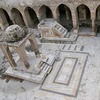Disclaimer
This entry contains information known to us from a variety of sources but may not include all the information currently available. Please be in touch if you notice any inadvertent mistakes in our presentation or have additional knowledge or sources to share. Thank you.
Archive
Central Synagogue, Aleppo, Syria
With a vast central courtyard built in a Byzantine architectural style, the Central Synagogue of Aleppo (Halab, ﺣﻠﺐ), also known as the Al-Bandara Synagogue and the Great Synagogue of Aleppo, is an ancient synagogue that was considered the main synagogue of the Jewish community in Syria while it functioned. Until its removal during anti-Jewish riots in Aleppo in 1947, the Aleppo Codex, which is noted for being one of the earliest known punctuated manuscript of the entire Hebrew Bible, was housed in the Central Synagogue. Despite the destruction done by the rioting, the Syrian Jewish community raised funds during the early '90s to partially restore the building which was placed under the protection of the Syrian government. The synagogue's current condition is unknown.
Description
History of the Synagogue: The Central Synagogue of Aleppo has existed since late Antiquity in Aleppo, possibly since the 5th century CE. Its earliest known inscription dates back to 834 CE. Early traditions surrounding its origin speculate that one of King David’s generals, Joab ben Zeruiah, built the synagogue following his conquest of Aleppo. Interestingly, during the Mongol period in the 13th century, the Central Synagogue was one of the six designated buildings of refuge in the city. The synagogue accommodated the growth and diversity of Aleppo's Jewish community, whose indigenous members were augmented in the 1500s by a contingent of Spanish origin. Separate prayer groups for each sub-community were held in different chapels, with the western wing for the indigenous community and the eastern wing for "newcomers." However, parts of the synagogue were damaged in the Mongol ransack of Aleppo in 1400 and it was turned into a mosque. (1) From 1405 to 1418, the central synagogue was rebuilt and underwent extensive modifications. (2) The synagogue was destroyed during the violent attacks against Jews of Aleppo by local populations in December of 1947, as a result of the United Nations’ support of partitioning the Palestine Mandate. Despite the looting and burning of the synagogue during these riots, the Central Synagogue still stands and was under the protection of the Syrian government. The Syrian Jewish community of New York helped finance the rebuilding of the synagogue in the 1990’s, and the rebuilding process was completed in 1992. However, the synagogue is empty and inactive today. (3)
Appearance of the Synagogue: The detailed recordings of the appearance of the Central Synagogue by Italian Jesuit Pietro della Valle in August of 1626 are valuable because they reveal the original appearance and architecture of the synagogue before its destruction in 1947. He noted that one enters the synagogue from a gated street that lies much lower than other streets, requiring him to descend a few steps to enter. He describes the synagogue as a “good large square uncovered court, with covered walks or cloysters round about, upheld by double pillars.” (4) This courtyard, apparently included in the original design, functioned as an open-air synagogue in the summers. Haim Ghiuzeli notes that some synagogues in the Middle East did not have roofs because “some hints in the Talmud suggest that it was customary for a synagogue to have its roof removed during the summer.” (5) This courtyard was surrounded by porticoes and contained a “raised, covered reader’s platform around which the congregation sat.” (6)
The central courtyard was one of the three main parts of the synagogue. Adjacent to the courtyard was the western wing, where the “mustarabi” community worshipped (the older, established Arabic-speaking Jewish community). The eastern wing of the synagogue was built in the 16th century and served as the prayer hall for Sephardi Jews that arrived in Aleppo after the Spanish exile.
On the southern end of this eastern wing, facing Jerusalem, is a small room known as the “cave of Elijah,” which housed the Aleppo Codex. (7) The Codex was written around 930 CE in Tiberias, and was the pride of the Jewish Aleppo community. (8) They viewed the Codex as a “talisman that protected the community” and thus allowed only a few to view it. (9) After disappearing during the anti-Jewish riots in 1947, the Codex appeared in Israel under mysterious circumstances. Once it arrived in Israel, the Codex became the subject of a legal battle between Israeli officials and the Jews of Aleppo. (10) It sits today in the Israel Museum in Jerusalem, with about 40% of its pages missing after its removal from Aleppo.
Jews of Aleppo: Jewish communities have populated Syria since ancient times; Aleppo was one of the main Syrian cities where Jews resided. Jewish history in Aleppo goes back to the days of King David’s reign over 3,000 years ago. Several biblical books suggest that Aram Soba, the biblical name for Aleppo, was part of the extended northern Israel kingdom. Aleppo was the “crown of the Sephardic world” (11). Under Turkish rule, Aleppo was the dominant trading center in Syria. Records from the British Levant Company reveal that Jews of Aleppo were heavily involved in the international trade along the caravan route. Sephardic Jews, who could dialogue in Spanish, Italian, and Arabic, worked as interpreters in this trade route. (12) The advent of the Suez Canal in 1867 was disastrous for the Aleppo Jewish community, as it destroyed their jobs in trade. As a result, more than half of Aleppo’s rabbis moved to Jerusalem. Following the violent riots in 1947 against the Jews in Aleppo and the creation of the state of Israel, most Jews in Aleppo migrated to the US and Israel. A vibrant community of Syrian Jews exists in Brooklyn and several smaller ones have grown in Deal, New Jersey and parts of Central and South Americas, but no Jews remain in Aleppo today. (13)







